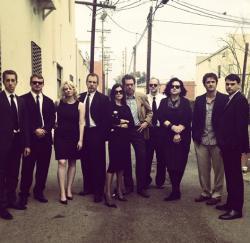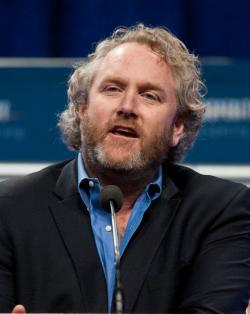After the funeral, on March 6, Andrew Breitbart’s successors drove back to the office. Breitbart.com world headquarters sits in an unincorporated part of Los Angeles. (It’s not really part of any city. This is a selling point.) Ten of the website’s editors filed out to the alley. They arranged themselves side by side in their best Reservoir Dogs poses. Click. Dana Loesch, the Tea Partier, CNN contributor, and editor of Breitbart’s Big Journalism vertical, stood in the middle of the frame. She put the picture up on Instagram. The caption was a Twitter hashtag: #war.
“We took that picture to say, ‘Hey! We’re still here,’ ” said Mike Flynn, the editor of Breitbart’s Big Government vertical, when I talked to him this week. “We’re going to carry out Andrew’s vision.”
Left side of the photo: Joel Pollak, Breitbart.com’s editor in chief, who slowly took over that role after coming in as a legal counsel. Right side: Ben Shapiro, a conservative columnist who’d become the site’s editor at large. Larry Solov, Breitbart’s best friend and business partner, thought the pairing was hilarious. “You’re looking at our two Orthodox Jewish, Harvard Law-grad bookends!” he said when I showed him the photo.
The bookends were not famous people. They were soft-spoken; Breitbart really, really wasn’t. But the day after the photo was taken, they were on Fox News, promoting a scoop—a 1990 video of Harvard Law student Barack Obama embracing critical race theory pioneer Derrick Bell—that Breitbart had been readying before his death.
Every time they upload a story or tweet, Breitbart.com’s editors are answering a question: How do you keep this stuff going without your star? Can you keep getting on CNN and Fox and the Drudge Report? Does your inbox keep filling up with tips and video scoops? How do you replace Andrew Breitbart?
You really don’t. Breitbart’s death was commemorated by memorials in L.A., New York, and—twice—in D.C. The admiring bloggers who put on the first D.C. memorial went on to start the Breitbart Scholarship. Ideally, board members like James O’Keefe will use it to dole out cash for enterprising student journalists.
The second D.C. memorial, which I attended last night, was held at the Newseum in a theater a few steps away from a giant slab of the Berlin Wall. Four members of Congress gave speeches paying tribute.

“I don’t know anyone who can, with clarity, articulate the left and what they’ve done over the last 100 years,” said Rep. Steve King, an Iowa Republican, after the memorial. “I didn’t think I was the only one who understood it, but when I read his book, I realized—wow, he really understood it. Marcuse, the Frankfurt School, all of that.”
The tribute ended with a short video tribute by the makers of the upcoming documentary Hating Breitbart. The #war hashtag started with their original trailer. It ends with Breitbart closing a long rant with, “Fuck you,” staring at the camera for a few seconds, then saying, “War” like he was trying to spook somebody out of the hiccups.
“We didn’t even push that hashtag,” said Andrew Marcus, the director of the documentary. He rattled off some of the other Breitbart memes that have spread since the Web pioneer died. “IAmBreitbart, BreitbartIsHere, the posters—that’s all organic. Nobody’s planning that.”
Breitbart.com, though—this was very carefully planned. The site relaunched and ran the Derrick Bell/Obama story within days of its founder’s passing. All of Breitbart’s old sites—Big Hollywood, Big Government, Big Journalism, Big Peace, Breitbart.tv—were consolidated in one place. Scoops were put next to movie trailers, next to election analyses, next to a simple form to submit news tips, with this epigram.
“We have a sea of new media to capture the lies”
- Andrew Breitbart, April 15, 2010
Washington, DC Tea Party Rally
The idea is to keep doing Breitbart-style work, split between a team of previously more-obscure apostles. Steve Bannon directed the Sarah Palin-friendly documentary The Undefeated and collaborated with Breitbart on a documentary about the 99 Percent movement titled Occupy Exposed. He’s taken over Breitbart News Network, LLC as executive chairman; Solov has taken over as CEO.
“It was the investors’ call,” explained Bannon, talking to friends after the D.C. memorial service. (The day Breitbart died, Bannon was meeting with investors in New York.) Obviously, the chairman and CEO jobs had to be split, because Breitbart wasn’t replaceable. “He was a combination of Falstaff and Marshall McLuhan. A larger-than-life guy who understood the media. You can’t replace that. In combat, you learn that most of the best guys are going to die first. They’re going to run toward the gunfire. Those guys are leaders. The key is making the unit bind together after that, and push forward.”
Watching “the unit” move is like watching a school of piranhas. It flits around quickly, randomly, until a hunk of meat hoves into view. That’s when it attacks. Take the example of Twitter. Breitbart used it to retweet people who hated him, warn of upcoming scoops, and get into random insult-flinging contests. John Nolte, who edits Big Hollywood—he’s the glasses-and-beard guy in the #war photo—cops the Breitbart style. Dana Loesch, whose CNN contract makes her the most prominent of the new Breitbartians, uses a lot of the same tricks, only harsher. She endlessly needles Media Matters senior fellow Eric Boehlert for employing M.J. Rosenberg, who slings the term “Israel Firster” even though it was coined by white supremacists. Boehlert, who’d carried on a Spy vs. Spy relationship with Breitbart for years, alternately blows her off or asks why CNN employs her. When I asked Boehlert how the new Breitbartians were doing, he laughed out loud.
“I don’t think Breitbart hired very strong editors to work for him,” he said. “Take the Derrick Bell story. The only pick-up it got was in its own corner of the Internet.” He wasn’t impressed at how Fox News covered the story? “I don’t count Fox. In the real world, no one paid attention.” The Daily Show covered the story, too, but we can move on. When Breitbart ran the shop, they scrambled to combat the ACORN tapes and pieces about the past of the openly gay “education czar” Kevin Jennings. The danger seems to have passed. “They’re having trouble sustaining it.”
They’ve been at it for less than a month, though. Absolutely, they’re in a stiffer competition now for the sort of stories the Breitbart sites excelled at. The Derrick Bell video was partially scooped by BuzzFeed, whose Andrew Kaczynski found a different version of the same tape. Breitbart.com wanted the video to launch its “Vet the Prez” campaign; BuzzFeed spoiled the punch. Part of the Breitbart.com response was a new scoop video of professor Charles Ogletree bragging about “hiding” the Bell/Obama tape in 2008. The rest of the response: a question-begging campaign against the other site, asking why they’d timed it this way, how much they paid, whether anything was clipped out.
Would Breitbart have handled it that way, with so much umbrage? It doesn’t matter. The new Breitbartians are the people he hired. They were already running most of the Breitbart network by the time he died.
“He took a year to assemble the best team and assemble the best technology,” said Steve Bannon. “When he got obsessed with something—you know what he was like when he got obsessed with something.” Sure. It was thrilling to watch, and incredibly tough to copy.
